Did you know nearly half of all bird species are songbirds? This fact shows how diverse our bird friends are. Each has its own name and special traits. From the tiny hummingbird chick to the big eaglet, the world of baby birds is full of wonder.
Key Takeaways
- Baby birds are called chicks, hatchlings, nestlings, and fledglings, based on their age.
- Knowing these terms helps us understand their needs and care.
- Some birds, like swans and eagles, have special names for their young.
- Learning about baby bird names is key for birdwatching and helping wildlife.
- Joining events like the Great Backyard Bird Count helps track bird numbers.
Understanding Baby Bird Terminology
The world of birdlings is full of special terms for baby avians and young ornithological offspring. Knowing these terms is key for bird lovers, naturalists, and anyone curious about birds.
Common Terms for Young Birds
The main terms for baby birds are hatchling, nestling, and fledgling. These names show the different stages a bird goes through, from egg to flying free.
Why Different Names Matter
Using specific names for baby avians is very important. Each name tells us about the bird’s needs and how grown it is. This helps bird watchers, wildlife helpers, and pet owners care for the birds right.
Basic Classification of Baby Birds
Baby birds are either altricial or precocial. Altricial chicks need a lot of care, while precocial chicks can do more on their own. Knowing this helps us understand their needs and how they act.
“The terminology used for baby birds has evolved over time, reflecting the rich diversity of our avian friends and the depth of our understanding of their lives.”
From the tiny hatchlings to the growing fledglings, the words we use for baby avians give us deep insights into their world.
What Do You Call Baby Birds?
When we talk about baby birds, we often use the term “chick.” But, the names for young birds change based on their age and type. For example, we call ducklings and goslings by their specific names. This shows how different these young birds are.
“Chick” is a general term, but it’s more precise to call them by their growth stage. Hatchlings, nestlings, and fledglings each have their own look and needs. Knowing these differences helps us care for these young birds better.
| Baby Bird Term | Species |
|---|---|
| Poult | Baby chicken |
| Colts | Baby cranes |
| Squab or squeaker | Baby doves |
| Ducklings | Baby ducks |
| Eaglet | Baby eagles |
| Eyas | Baby falcons or hawks |
| Goslings | Baby geese |
| Cheepers and squealers | Baby grouse |
| Keets | Baby guineafowl |
| Loonlet | Baby loons |
| Owlet | Baby owls |
| Pufflings | Baby puffins |
| Peeps | Baby sandpipers |
| Cygnet and flapper | Baby swans |
| Poults, jakes, and jennies | Baby turkeys |
Learning about the different names for young birds helps us see their unique qualities. It shows how special each type of chick, duckling, and owlet is.

From Egg to Flight: The Development Stages
The journey from egg to flight is amazing for baby birds. These young ones, called hatchlings, nestlings, and fledglings, go through key stages before flying.
Egg Period
The egg period is the beginning of a bird’s life. The incubation time varies by species, from a few days to weeks. In this time, the embryo grows and gets ready to hatch.
Early Development
After hatching, the early development starts. New hatchlings are naked and need their parents for food and warmth. As they grow into nestlings, they get feathers and become stronger, ready for their first flights.
Pre-flight Stage
The pre-flight stage is very important for young birds. Fledglings grow their flight feathers and start practicing flying. They learn to fly short distances around the nest, building skills and confidence for flying alone.
The time it takes for these stages can vary a lot, from days to months. Knowing the specific needs and times of these young birds is key for their care and protection.
“Bird development is a captivating process that showcases the incredible adaptations and resilience of these winged creatures.”
Hatchlings: The Newly Born Birds
Hatchlings are the newly born birds that capture our fascination. These fragile, featherless, and blind birds rely on their parents for survival. Their journey from helpless newborns to self-sufficient fledglings is remarkable.
Each species of hatchling has its own unique traits. Some, like young chickens, can walk and forage soon after hatching. Others, like songbird hatchlings, stay in the nest for weeks, growing and developing their feathers.
The baby ostrich is the world’s largest hatchling, weighing up to two pounds at birth. On the other hand, the Bee Hummingbird chick is the smallest, almost invisible to the naked eye. These differences show the incredible diversity of baby avians.
“Hatchlings are the embodiment of nature’s resilience, their helpless yet determined spirits captivating the hearts of all who witness their journey.”
As these recently hatched fowl move from the egg to the world, they face many challenges. Their parents play a crucial role in their survival. Learning about their unique needs helps us appreciate the wonders of baby avians.
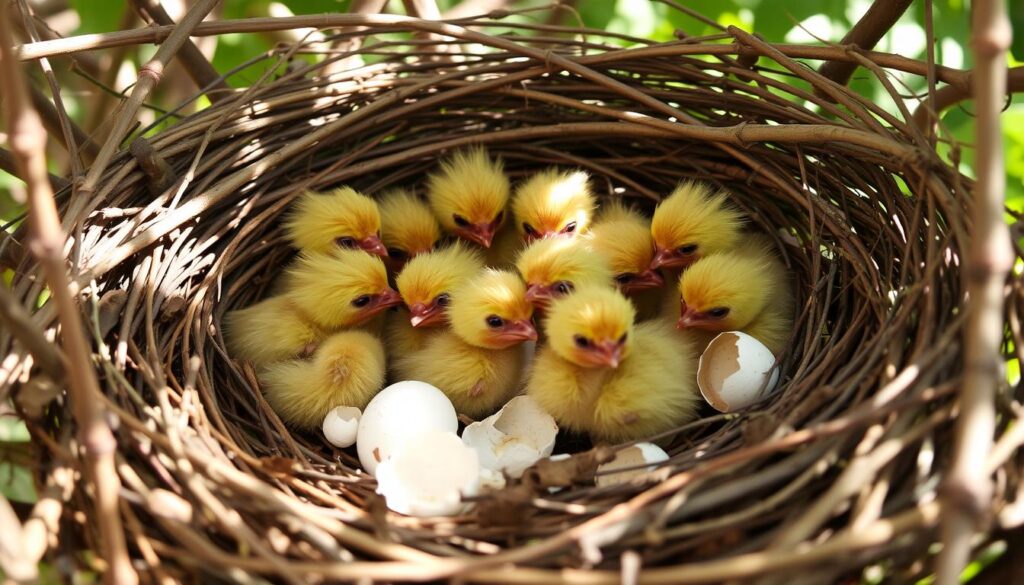
Nestlings: The Growing Stage
As young ornithological offspring, or birdlings, move from the hatchling stage, they enter a key period called the nestling stage. Nestlings, baby birds a few days old, have soft, downy feathers and open eyes. They also start to grow wing and tail feathers as tubes. Even though they’re not ready to fly yet, these birdlings need constant care from their parents for food and warmth.
Physical Characteristics
Nestlings grow and develop quickly during this stage. Their feathers grow fast, and their bodies grow even faster as they get ready for their first flights. This fast growth is vital for the young ornithological offspring to become independent.
Parental Care Requirements
- Feeding: Nestlings rely completely on their parents for food, needing to be fed often during the day.
- Protection: Parents watch over the nest closely, keeping their birdlings safe from predators and harsh weather.
- Temperature regulation: Newborn nestlings can’t keep themselves warm, so they rely on their parents’ body heat.
Without their parents’ care, nestlings face a big risk of not surviving. This stage is critical for the young ornithological offspring to learn and grow strong enough to leave the nest and live on their own.
“Nestlings are the most vulnerable stage of a bird’s life, requiring constant attention and care from their parents to ensure their survival and successful transition to adulthood.”
Fledglings: Learning to Fly
As juvenile feathered creatures grow, they enter a key stage called the fledgling phase. Fledglings are baby birds with feathers but still learning to fly. They hop, walk, or flutter, needing their parents for care and guidance.
This stage is vital for young birds as they practice flying and finding food on their own. Smaller birds may leave the nest in just ten days. But larger birds, like Bald Eagles, may stay in the nest for over three months.
Even though they can move around, fledglings still rely on their parents. As they get better at flying, they become more independent. They eventually reach the subadult and adult stages of their lives.
| Developmental Stage | Characteristics |
|---|---|
| Hatchling | Newly hatched baby birds, some with feathers |
| Nestling | Baby birds still in the nest, unable to fly, reliant on parents |
| Fledgling | Birds in their first coat of feathers, capable of moving independently but not yet fully flighted |
| Subadult | Birds with plumage between juvenile and adult stages |
| Immature | Birds not yet adult, including those with juvenile or subadult plumages |
The fledgling stage is a critical and often misunderstood part of a baby bird’s life. By understanding these juvenile feathered creatures, we can appreciate their growth and transition to adulthood.
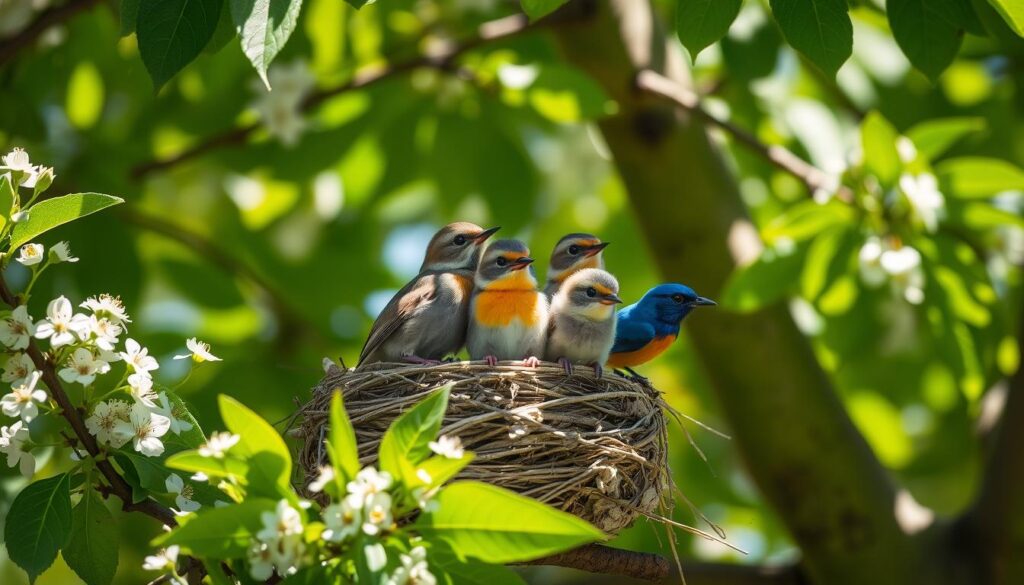
Special Names for Water Bird Babies
Water birds have their own special names for their young. Ducklings are the cute babies of ducks. Goslings are the young of geese. And the graceful cygnets are the young of swans.
But there are more than just these common names. Coastal and marine birds have their own names too. For example, baby loons are called loonlets, and puffin chicks are known as pufflings. These birds often nest high up, and their chicks must jump far to reach the water or ground.
| Baby Bird | Species | Name |
|---|---|---|
| Duck | Duckling | |
| Goose | Gosling | |
| Swan | Cygnet | |
| Loon | Loonlet | |
| Puffin | Puffling |
The variety of names for water bird babies shows how unique each species is. Learning these names helps us appreciate the amazing world of birds.
Birds of Prey and Their Young
The young of birds of prey, like eagles, owls, and hawks, have special names. They are called eaglets, owlets, and eyas. These chicks take longer to grow up in the nest compared to other birds.
Eaglets and owlets go through a “branching” phase before they fly. They hop and jump around the nest to get their wings ready. This is a key step before they take their first flight.
- Chicks of the same clutch hatch over several days. This helps them adapt to unpredictable food supplies.
- The nestling period lasts from four to seven weeks. Larger species take longer than small ones.
- Small species grow faster than large ones. Small species reach adult weight by the time they fly.
- Postfledging periods vary. Small falcons take two to three weeks, while large eagles and vultures take months.
Raptors, or birds of prey, have short, hooked beaks and long, sharp talons. Their young, eaglets, owlets, or eyas, may be left alone for up to four hours. This is while their parents hunt for food.
| Characteristic | Details |
|---|---|
| Branching | Most young raptors “branch,” leaving their nest to stay on nearby branches while growing. |
| Nest Duration | Some raptor young stay in the nest until fully grown and capable of flight. |
| Reuniting | Recommended to reunite raptors during the daytime, except owls, which should be reunited at dusk or nighttime. |
| Fledgling Care | Fledglings can fall to the ground and should be placed back in their nest if safe. Monitor fledglings for four hours from a distance to see if parents return. If parents don’t return within eight hours or the fledgling’s condition worsens, bring the bird for evaluation and potential rehabilitation. |
Renesting raptors can be tough, but it’s key to protect these young birds. They are on their way to becoming adults.
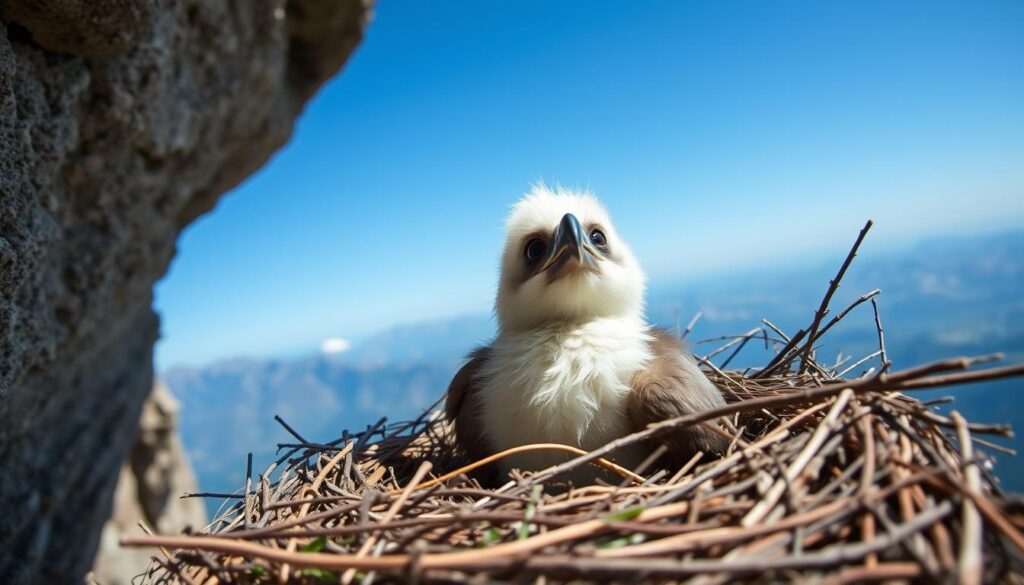
Unique Names for Game Bird Chicks
Game birds have special names for their young. These names show their unique traits. From backyard chickens to wild birds, the names are both interesting and informative.
Domestic Poultry Terms
In domestic poultry, “poult” means baby chicken or turkey. Male chickens are called cockerels, and females are pullets.
Wild Game Bird Offspring
Wild game bird chicks have their own names too. For example, guineafowl chicks are keets. Grouse chicks are known as squealers. Partridge chicks are called cheepers, named for their sounds.
These names enrich our understanding of birds. They give us a peek into their behaviors and traits.
| Baby Bird Name | Species | Meaning/Explanation |
|---|---|---|
| Poult | Chicken, Turkey | Baby domestic poultry |
| Cockerel | Chicken | Young male chicken |
| Pullet | Chicken | Young female chicken |
| Keet | Guineafowl | Baby guineafowl |
| Squealer | Grouse | Baby grouse |
| Cheeper | Partridge | Baby partridge |
Learning these names deepens our understanding of birds. It shows the amazing diversity of the bird world. By knowing these names, we appreciate the complex lives of game birds more.
The Difference Between Precocial and Altricial Chicks
Not all baby birds are the same. Some, like ducklings and chickens, are very mature and independent from birth. These are called precocial chicks. On the other hand, songbirds, hawks, and herons have altricial chicks. These are helpless, blind, and naked, needing lots of care from their parents.
Precocial chicks are ready to go from the start. They can walk, find food, and keep warm soon after hatching. Altricial chicks, however, need their parents for everything. They rely on them for food, cleaning, and safety.
This difference affects how these birds start their lives. Precocial birds like ducks need less care from their parents. But altricial birds, like songbirds, need a lot of help and attention.
| Characteristic | Precocial Chicks | Altricial Chicks |
|---|---|---|
| Appearance at Hatching | Covered in down feathers, able to walk | Naked, blind, and helpless |
| Feeding Behavior | Can find and eat their own food | Depend on parents for feeding |
| Mobility | Able to leave the nest shortly after hatching | Remain in the nest, unable to leave |
| Parental Care | Require less intensive care | Require extensive parental attention and care |
This big difference shows how different bird species have evolved. Knowing about precocial and altricial chicks helps us understand how baby birds start their lives.

Baby Bird Development Timeline
The lives of nestlings and fledglings are a captivating journey. They go through rapid transformations and reach remarkable milestones. The development timeline varies across different bird species. Yet, understanding the key stages offers valuable insights into their growth and care.
Week-by-Week Growth
At first, hatchlings emerge from their eggs, often naked and helpless. In the next one to two weeks, these vulnerable nestlings start to grow feathers. They also learn to perch and hop, but still need their parents for food and protection.
As they grow, nestlings move into the fledgling stage, usually around 13-14 days. Now, they have a full coat of feathers and try short flights. But, they still get care from their devoted parents.
Milestone Markers
- Hatchling stage (0-3 days): Eyes closed, naked or with sparse down, unable to walk or perch.
- Nestling stage (3-13 days): Feathers emerging, able to hop and perch, still heavily dependent on parents.
- Fledgling stage (13 days+): Fully feathered, attempting short flights, still receiving parental care.
The timeline of this transformation varies due to species, diet, and environment. Proper nutrition and attentive care are key. They ensure the healthy growth and success of these baby avians.
| Stage | Characteristics | Duration |
|---|---|---|
| Hatchling | Naked or sparse down, eyes closed, unable to walk or perch | 0-3 days |
| Nestling | Feathers emerging, able to hop and perch, heavily dependent on parents | 3-13 days |
| Fledgling | Fully feathered, attempting short flights, still receiving parental care | 13 days+ |
“The journey of a thousand miles begins with a single step.”
Interesting Facts About Baby Birds
The world of young birds, or birdlings, is full of amazing facts. They have special ways of eating and growing up. These tiny birds always surprise us.
Some birds, like pigeons and flamingos, feed their babies a special milk. This milk is full of nutrients and helps the young birdlings grow strong. Also, hummingbirds lay eggs that are as small as coffee beans.
Some chicks, like those of the cuckoo bird, are raised by other birds. This is called brood parasitism. It helps the cuckoo chicks grow without using much energy.
“The diversity of baby bird adaptations is a testament to the incredible evolutionary ingenuity of the avian world.”
The young ornithological offspring of birds are truly amazing. They show us how birds have evolved to survive. These birdlings give us a peek into the fascinating world of bird biology.
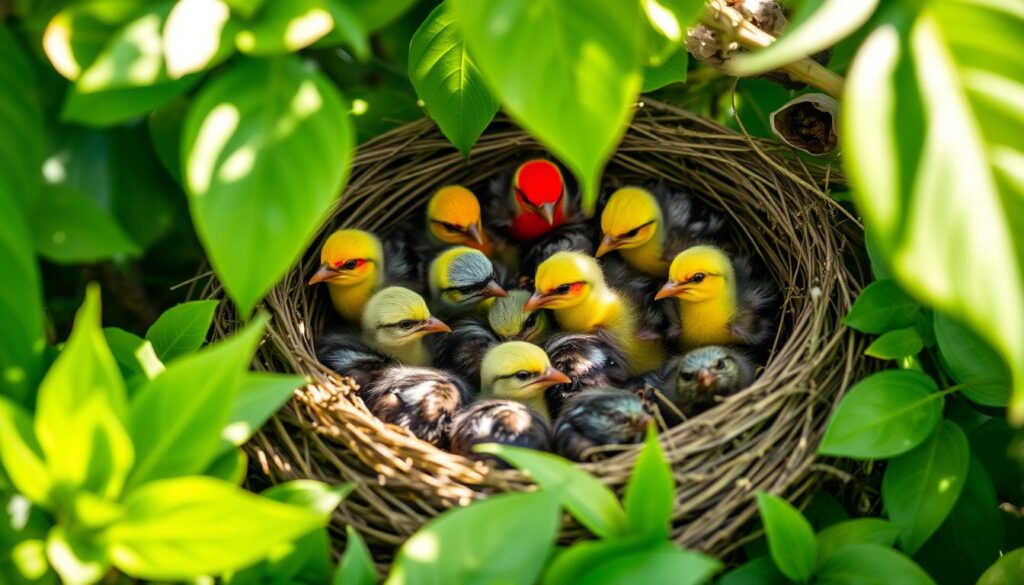
| Fascinating Baby Bird Facts | Statistics |
|---|---|
| Percentage of baby birds hatched as altricial young | 75% |
| Percentage of baby birds hatched as precocial young | 25% |
| Average age at which baby birds transition from nestlings to fledglings | 14-21 days |
| Percentage of baby birds classified as subadults before reaching full adult plumage | 80% |
| Average age at which large birds like bald eagles and certain gulls reach full adult plumage | 4-5 years |
Baby Bird Care and Protection
Natural Parental Care
Baby birds get amazing care from their parents. Mothers and fathers work hard to feed, warm, and protect them. Fledglings, young birds just out of the nest, are fed and cared for by their parents.
These fluffy, hopping chicks are still watched over by their family. Even if they’re not in the nest anymore.
Human Intervention Guidelines
It’s natural to want to help baby birds, but knowing when to step in is key. Usually, it’s best to leave fledglings alone. Their parents are nearby, taking care of them.
If you find a nestling, or if the parents are gone, call a licensed wildlife rehabilitator. They know how to give the baby bird the right care.
Don’t handle wild baby birds. It can make them lose their natural instincts. Instead, make bird-friendly habitats and offer nesting boxes. This helps local bird populations thrive without needing human help.
FAQ
What are the common terms for young birds?
Young birds are called hatchlings, nestlings, and fledglings. Each term shows the bird’s age and what it needs to grow.
Why do the different names for baby birds matter?
Knowing the names like hatchling, nestling, and fledgling is key. It tells us about the bird’s age and how to care for it. This is important for bird lovers, scientists, and those who keep birds as pets.
What are the basic classifications of baby birds?
Baby birds are either altricial (born helpless) or precocial (born more developed). This affects how they live and what they need early on.
What are the stages of baby bird development?
Baby birds go through several stages. These include the egg period, the early stages (hatchling and nestling), and the pre-flight stage (fledgling). Each stage has its own needs and timeline, depending on the species.
What are hatchlings, and how do they differ from other baby birds?
Hatchlings are birds right after they hatch. They are usually featherless and blind. They need their parents a lot because they can’t do much on their own.
Some hatchlings can walk soon after hatching. Others stay in the nest for weeks.
What are nestlings, and what are their care requirements?
Nestlings are baby birds a few days old. They have down feathers but can’t leave the nest yet. They need their parents to feed and keep them warm.
What are fledglings, and how do they differ from other baby birds?
Fledglings are young birds with feathers who have left the nest. They may not fly well yet. They still get help from their parents as they learn to fly and find food.
What are the unique names for water bird babies?
Water bird babies have special names. For example, ducklings are baby ducks, and goslings are baby geese. Swans have cygnets. Sea birds like loons and puffins have their own names too.
What are the names for the young of birds of prey?
Birds of prey have their own names for young ones. For example, eaglets are baby eagles, and owlets are baby owls. Hawks and falcons have eyas. These chicks often stay in the nest longer.
What are the unique names for game bird chicks?
Game bird chicks have their own names. For instance, a baby chicken or turkey is called a poult. Guineafowl chicks are keets. Grouse and partridge chicks are called squealers and cheepers, respectively.
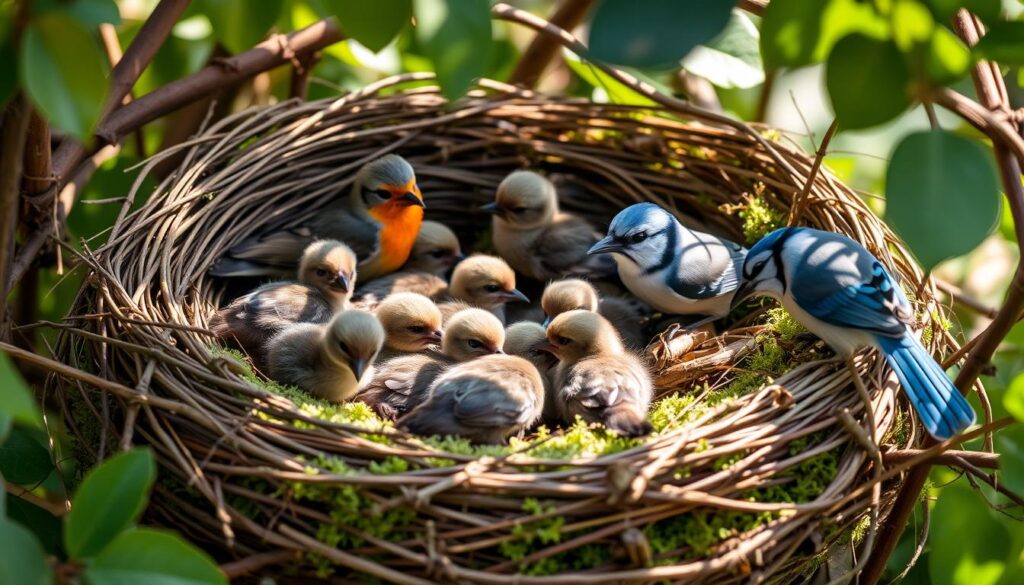

Hello, i think that i saw you visited my blog thus i came to “return the favor”.I am attempting to
find things to improve my site!I suppose its ok to use
some of your ideas!!
Here is my blog post: nordvpn coupons Inspiresensation (T.co)
I think everything published made a ton of sense. But,
what about this? suppose you were to write a awesome headline?
I am not suggesting your content is not solid, but suppose you added something that makes people desire more?
I mean What Do You Call Baby Birds? Guide
to Baby Bird Names – We Love Talk Birds is a little plain.
You could peek at Yahoo’s front page and watch how they create article headlines
to get people interested. You might add a video
or a pic or two to grab people excited about everything’ve got to say.
In my opinion, it would bring your posts a little bit
more interesting.
My webpage :: nordvpn coupons inspiresensation
nordvpn 350fairfax
This is really interesting, You are a very skilled blogger.
I have joined your rss feed and look forward to seeking more of your wonderful post.
Also, I’ve shared your web site in my social networks!